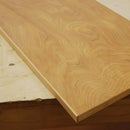Introduction: Plasma Cut Steel Ties for Wood Joinery
Tools and Materials Required:
- Boards milled to the same thickness
- 1/8 inch steel plate
- C.N.C. or handheld plasma cutter
- C.N.C. wood router
- Oxy-Acetylene torch
- Table saw
- Router table
- Deadblow or rubber mallet
- Ball peen hammer
- Slag hammer
- Sandpaper
Step 1: Cutting the Ties
The steel ties can take on a variety of designs. They can simply be one inch wide strips of steel cut to anywhere between ten an twenty inches in length. In this design, the ties have an oval center connecting ten inch long strips. The important part is to design the tie so that there is enough material to hammered through and wrapped around the wood. TechShop Menlo Park's C.N.C. plasma cutter was used to maintain consistency and speed up the process; whatever design is chosen can also be cut by hand.
Load the steel plate onto the plasma cutter. For 1/8 inch plate, set the plasma cutter for 40 amps and run it at about 65 inches per minute. Once finished, remove the ties with a pair of pliers (they'll be very hot) and remove any slag buildup on the back with a hammer. An angle grinder with a flap disk can also be utilized for this purpose as well as adding a finish to the steel.
Step 2: Prepping the Boards and Cutting the Inlay
To keep the boards planer along the seam, cut a rabbet into the adjoining edges of each piece. The rabbet should be half the thickness of the board in order to provide the most strength. Do make the cut in one pass; start at a lower depth and progressively raise the rabbeting bit until the desired final cut is achieved. Check the joint after each pass and be careful not to cut the groove too deep.
The inlay can be cut by hand, but TechShop Menlo Park's C.N.C. ShopBot wood router was used to preserve accuracy. The inlay should be cut to just over the dimensions of the tie. If the tie was cut using the C.N.C. plasma cutter, the same file can be used for both machines, as the kerf of the plasma will allow the tie to be inset. The slots where the steel will be bent through the wood should be cut wider than the thickness of the metal (approximately 0.010 inches wider).
Affix the boards to the machine table of the C.N.C. wood router with screws, making sure the rabbet joint is pulled tight. If using this method, it is recommended that the boards are cut wider than the final dimensions so that the screw holes can be removed on the table saw when final dimensioning takes place. Cut the inlay, and remove any tear out with 150 grit sandpaper.
Step 3: Bending and Inserting the Tie
Place the tie over the inlay and mark the bend points with a sharpie. Make 90 degree bends in the steel using a press brake; the more accurate the bends are, the easier it will be to insert the tie.
Place the boards on a even surface, and slightly clamp them together to prevent the joint from spreading. Use a deadblow mallet to tap the bends into the grooves cut in the wood. Turn the assembly over, and, placing a scrap board over the joint, hammer the boards onto the tie. Be sure to hammer evenly across the seam to prevent the wood from splitting.
Step 4: Wrapping the Tie
Set up your oxy-acetylene torch to heat bend the tie around the under side of the wood. The size torch head used is based on aesthetic and utility. Smaller flames will mean the heating time is increased, and thus char the wood more. Larger flames will decrease the heating time and the char. A 00 welding tip was used for this version. A larger flame will be utilized in the next iteration to keep the material from charring so much.
Keep a bucket of water handy and bend one strap at a time. Pour water on the wood around the strap to be bent, and heat the steel evenly in a small section. The steel need only be hot enough to bend. The wood will ignite around the steel and char. Again, the bigger the flame, the more the charring will be minimized. Remove the torch from the material to keep the flames down, but do not use water to put out the flame. Once the metal is heated, hit the strap with a ball peen hammer, until it is bent at about 90 degrees. Keep heat on the material as you bend it, After the steel touches the wood, quench immediately with water to pull the joint tight. Repeat the process until all remaining straps are finished.













